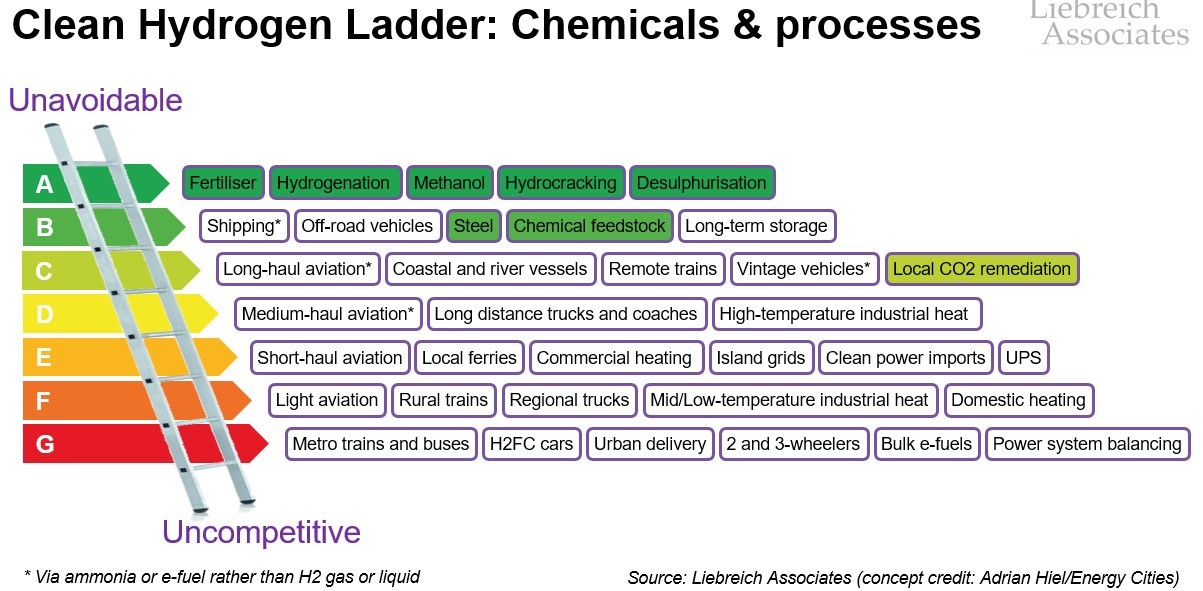Towards a workable post-Kyoto international framework for emissions reduction
This is a white paper I published in December 2005 – seven years ago – in which I branded the Kyoto Protocol a failure and described an alternative approach for bringing countries into an accession-based system for emission controls, similar to the largeyly successful Nuclear Non-Proliferation Treaty. Under “Accession to GDP Less X%”, all countries would have the same goal: emissions to undershoot GDP growth by the same percentage. With the UNFCCC having essentially run into the sand, we need to look again at new approaches.
London, 8 December 2005. Republished 24 October 2012
Less than a year after the ratification of the Kyoto Protocol, it is sobering to see that the most important question in climate policy circles is what should happen when Kyoto falls away in 2012. Opinions span the full range, from those who would like to see Kyoto’s life extended for a further five year commitment period, to those who would like to see it die and nothing replace it.
The Kyoto Protocol has served a useful purpose in educating the public, building consensus on the need for action, and gaining valuable experience in the design and operation of mechanisms to combat climate change. It has also served to educate the political, financial and business worlds with regard to the relationships between economic growth, development and the risk of climate change.
The Kyoto process has, however, been revealed to be deeply flawed, both in its design and in its execution. Here at New Energy Finance, we believe that fundamental re-engineering will be required for any successor regime to provide a workable international framework for the reduction of greenhouse gas emissions.
In this paper we outline a possible alternative architecture for a successor regime, based on a single flexible emission reduction target for all countries and the principle of a treaty accession process, such as that which has resulted in other successful multilateral organisations.
Ultimately, the success of any effort to limit future growth in CO2 emissions will come down to one basic question: how does it deal with India, China and Brazil? These three large, rapidly industrialising countries have a combined population today of just over 2.5 billion. If, as they develop, they reach the point where their emissions per capita reach half those of the UK, world emissions will have risen by nearly 40%. If they reach half of the US’s rate of emissions per capita, that would double the world’s current CO2 emissions. There are practically no serious scientists who believe that the world’s climate can withstand the resulting changes in atmospheric CO2 concentrations.
This focus on reining in carbon emissions from the developing world is not neocolonialism, it is an acknowledgement of reality: what the 2.5bn people in India, China and Brazil do is, in the long term, simply three times as important as what the 850m people in the US, Europe and Japan do.
Against this background, the Kyoto protocol has to be seen as an almost complete failure. The total target reduction (relative to the 1990 baseline) under Kyoto amounted to only 5.2% of global emissions, and all of it was to be borne by the developed world. For all the acres of newsprint expended on the evil of the US’s refusal to ratify the Protocol, such ratification would have contributed a mere 2% reduction in global emissions between 1990 and 2012 – a negligible amount.
Of course, the numbers don’t tell the whole story. The Kyoto Protocol, like any international treaty, is after all the result of a political and diplomatic process. Noone can realistically expect developing countries to shoulder the main burden of mitigating future emissions, particularly given the developed world’s overwhelming role to date in creating the problem. Nevertheless, coming away from the Kyoto process with no commitment of any kind from the developing world has to be seen as one of the greatest diplomatic disappointments of all time.
All this is, however, now in the past. As things stand, the Kyoto Protocol is set to fall away in 2012. Barring a seismic shift in the US political scene it is inconceivable that the treaty in its current form will bring the US and the developing world in from the cold. Indeed even some of the countries that have ratified Kyoto are openly calling it a mistake. Which raises the question of what should happen next.
At the macro level, the outcome is all but inevitable: after a period of posturing and arm-wrestling, a pact will emerge between the developed and developing worlds, either in the shape of a formal treaty or a voluntary consensus. How long this takes remains to be seen – Kyoto was born out of a process begun at the Rio Earth Summit of 1992, but it took until 2005 to be ratified. 13 years may be a long time in the life of a climate scientist or environmental lawyer, but it is little more than the blink of an eye for the planet.
At the end of 2004, the Pew Centre on Global Climate Change published a survey of more than 40 possible successor approaches to Kyoto, proposed by a wide range of academics, consultants and policy makers. The names of the various plans make evocative reading. Should we go for Graduation and Deepening, Extended Global Triptych or Keep it Simple, Stupid (which seems unusually complex, despite its name)?
The Pew list of possible post-Kyoto approaches is a fascinating document, vividly demonstrating how carbon mitigation lies at the crossroads of economic and political thought today. The Kyoto supporters want more time; the Neo-Marxists want to penalize former colonists; the Dirigistes want centrally planned efficiencies; the dreamers want a new Marshall Plan; the hard left wants global per capita emissions allowances; the game theorists want to change the rules; the free marketeers want to leave it all to the invisible hand of competition; and the diplomats wish the whole problem could be deferred until they have retired.
Here at New Energy Finance, our thoughts as to what an effective post-Kyoto regime might look like don’t quite match any of the approaches in the Pew study. We believe that any workable, binding international treaty to reduce emissions of greenhouse gases should be based on a nucleus of countries that accept emissions caps, which is then grown over time through an accession process.
The World Trade Organisation (formerly GATT), the Nuclear Non-Proliferation Treaty and the EU followed this route to build large international coalitions around a core of committed members. Initial signatories pick off non-signatories on a case-by-case basis over an extended period, encouraging institutional change and bringing a range of economic and diplomatic pressures to bear until it is in each country’s interest to accede.
Accession to the group of emissions-controlling countries should be based on a single, long-term target for annual CO2 emission reduction relative to the baseline figure at the time of accession. We suggest real GDP growth less 4%.
The world’s GDP growth has averaged around 3% for the past 30 years. Restricting growth in CO2 emissions to real GDP less 4% would therefore drive an average reduction of 1% per annum in CO2 emissions. Enough, during the course of the next 50 years to bring emissions back in line with the absorption capacity of the world’s lands and oceans. Developing countries would be allowed to grow their emissions, but not in an unlimited way; the developed world, where growth averages 2.5% or less, would be committed to meaningful reductions.
GDP-Less-4% is an ambitious target. Reaching it would require a combination of reducing energy intensity – i.e. energy used per unit of GDP – through efficiency savings and changes in consumption patterns, at the same time as taking carbon out of energy provision, through clean energy and/or nuclear power.
Most developed-world economies have reduced energy intensity by around 2% per annum for over 20 years. Between 1996 and 2005 even the big, bad US cut energy use per dollar of GDP by an average of 2.1% per annum, and that was without a particular policy focus on energy saving. Add in a shift towards zero- or low-carbon energy sources, and some element of carbon capture and sequestration, and the target is achievable. As an aside, if you think GDP-less-4% is too ambitious, you are implicitly conceding that the world has to give up either on economic growth or on climate change. Logically you should probably be selling your shares, buying gold, moving to higher ground, stockpiling drinking water and buying a shotgun.
This “Accession to Real GDP-Less-4%” approach has several attractions. The first being that, if successful, it would actually produce a solution on a scale commensurate with the problem (unlike Kyoto). Second, the process would provide long-term certainty about the world’s carbon “fiscal policy”, avoiding the stop-go nature of commitment periods and giving the world’s capital markets the stability required to invest over realistic asset lifetimes. Third, it explicitly acknowledges the need for the burden to be shared between the developed and developing world. Fourth, it avoids at a stroke the bureaucratic convolutions and openness to fraud of the CDM and JI process.
Fifth, and perhaps most importantly, the accession approach means that no single country or bloc can hold the process hostage.
The developing world will (quite rightly) point out the responsibility of the developed world for past emissions and expect concessions. The pain of accession could be significantly eased by the lure of funding and technology transfer from core treaty signatories: a process familiar to anyone who has watched negotiations over EU membership.
Once signed up, all countries would share the same targets and institutional processes as any other member. The Nuclear Non-Proliferation Treaty, ratified in 1970, included a provision for a general assembly after 25 years to decide whether it should continue in force. A similar provision could be included, to evaluate whether the GDP-Less-4% target remains appropriate over time, or should be modified; otherwise there should be no concessions made to the long-term target setting.
Although the discredited CDM and JI mechanisms would fall away under Accession to GDP-Less-4%, emissions trading would continue to play a key role. Upon accession, countries would be allowed to issue their agreed level of credits to their industrial players, who would then to trade them with the emitters of other treaty signatory states.
The EU-ETS is the most successful of the world’s various nascent carbon exchanges, showing some real signs of liquidity. Discussions are already under way about linking other exchanges or extending the EU-ETS to cover other countries; sharing a single long-term carbon reduction target would eliminate one of the main hurdles to such tie-ups – the fact that carbon credits from lax systems will never be interchangeable with those from ones with strict emissions reduction targets. And herein lies one of the keys to get the US back to the table. The risk of a global coalition to fight climate change crystallising around the EU – with London as its financial hub, a platform for technology sharing, and new levers of influence to use in a range of international negotiations – might just be enough to get the US back to the table.
Another important consideration for any post-Kyoto regime is to refocus on emissions, and exclude Land Use, Land-Use Change and Forestry (LULUCF). That is not to say that LULUCF cannot have a major impact on atmospheric CO2 – of course it can, and must – but that the institutional frameworks for emissions reduction become hopelessly complex once you include LULUCF. Put simply, emissions reduction is about industry and trade policy, whereas LULUCF is more to do with social and environmental policy. International efforts to modify land use and stop deforestation should be pursued within a completely separate treaty and organization from that governing emissions.
Export finance would be expected to play a much larger role in the promotion of clean energy in developing countries under this proposal than is possible under Kyoto’s mechanisms.
One of the key criteria for any country’s accession would be the strength of its compliance processes. It is hoped these would be more rigorously audited than the Greek central bank was during the run-up to the launch of the Euro. Under Kyoto, verification of carbon emissions allowances is outsourced to privately owned agencies, each of which effectively has the power to print money. An accession process would allow for a period of capability-building in verification, compliance and, most importantly, rigorous and independent auditing.
Which raises the final question: which forum or organisation should lead the process? Is the UNFCCC up to the task, or should the WTO take over? Most likely, especially given the need to bring the US back to the table, re-energising the process will require a completely new organisation; in any event it is clear that the effort will need to be led by a high-quality, high-profile political figure (memo to Tony Blair – any interest, once Gordon Brown has taken over your current job?).
——————————————————————-
London, 24 October 2012
How fascinating to re-read that piece with the benefit of seven years’ hindsight!
There are a couple of great Zeitgeist moments: addressing the pre-Gordon-Brown-Premiership Tony Blair, and assuming that Europe would continue to have the muscle to show global leadership. Aside from that, though, the piece has stood the test of time remarkably well – hence the decision to republish it here. The intervening years have only strengthened the importance of moving away from the idea that the world can be divided into rich leader and poor follower countries.
GDP-4% might not be quite ambitious enough – the right number is probably GDP-4.5%, given the continued (and much welcomed) rapid economic growth in the developing world. And given the speed of development of technology and the rapidity of climate-related changes, it might make sense to review the target every 5 or 10 years, rather than every 25. But the basic principle is as sound as ever.
Accession to GDP Less X% is entirely consistent with the Copenhagen 2 degree pledge: it would be pretty easy to translate from any expected global economic growth rate into the carbon intensity reduction required to hit 2 degrees. If science later says the target shoudl be 1.5 degrees, or 2.5 degrees, the trajectory can be adjusted accordingly. Although all countries would sign up to a single goal, because this goal is relevant to their own economic growth, the resulting approach is exquisitely “common but differentiated”. It is also consistent with the “Nice, Retaliatory, Forgiving and Clear” strategic framework which I described two years later, in 2007, and which we are now seeing increasingly is the emerging model for national action on climate.
Sadly, the main obstacle to a fresh discussion about the global climate framework is the lock-in to previous agreements. When so many people are wedded to so much unhelpful baggage, it is hard to see how we clear the decks and start afresh. But without question we need to do so.
Terms of use: photos and other media may be used exclusively for the purpose of publicising an upcoming or past event involving Michael Liebreich, or to illustrate an article written by him. Their use must be accompanied by a clear indication of copyright in the following form:
© Liebreich Associates/name of photographer. Photos or other media downloaded in this way remain the property of Liebreich Associates Ltd. Any infringement of these terms of use may result in legal action by Liebreich Associates Ltd or by the respective photographer or rights holder.





